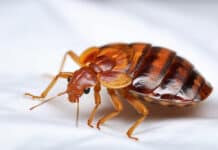By Benjamin Hottel, PhD, BCE, PCQI
Bed bugs may have been the talk of Paris Fashion Week, but how can they affect your non-residential facility? Contrary to popular belief, bed bugs do not only reside on beds. These pests can hide in many hard-to-see areas such as furniture, luggage, clothing racks, and almost anywhere there is a crack or crevice. Visitors may be carrying them unknowingly in luggage or packaging that enters your facility. Knowing how to spot these pests will help ensure the safety of your employees and customers, and ultimately protect your bottom line.
Bed Bug Threats In Commercial Facilities
Bed bugs are primarily attracted to areas where people sleep. In the 1990s, there was a resurgence of bed bugs across the U.S., mostly inside hotels and motels. While bed bug services slowed in 2020, experts believe bed bug infestations are on the rise again due to an increase in travel on trips that were postponed during the height of the pandemic.

Now, their presence is no longer solely a problem for the hospitality industry alone. U.S. pest control providers have reported treating bed bugs in multifamily dwellings, hotels, hospitals, senior living centers, schools, office buildings, dorms, hospitals, and in even public transportation.
How To Spot A Bed Bug
Bed bugs are extremely resilient pests. Typically, they are 3/16–1/4 inch long, red to dark brown in color, and mostly nocturnal insects that come out of hiding to take blood meals from humans. These pests are hematophagous, which means blood is their only food source.
Although bed bugs are visible to the naked eye, they are excellent at hiding. If you notice any of the following signs, you may have a bed bug issue in your facility:
- Small, live bugs located on furniture
- Clusters of dark brown or black spots of dried excrement on infested surfaces
- Subtle, sweet, musty odor
Bed bugs are known for rapid population growth. Females can deposit one to five eggs a day and may lay 200 to 500 eggs in their lifetime. They can survive for several months while waiting for their next blood meal, so they’re likely to emerge when a food source, e.g., humans or animals, becomes available.

How To Help Prevent Bed Bugs
Bed Bugs are highly stealthy pests, but there are certain measures you can take in your facility to help reduce the risk of an infestation:
- Inspect your facility for signs of bed bugs regularly. Check the places where they hide during the day, including mattress tags and seams, and behind baseboards, headboards, wall art or mirrors, curtains, closets, and electrical outlets.
- Decrease clutter to make it easier to spot bed bugs on your own or during professional inspections.
- Examine all secondhand furniture before bringing it inside your business.
Bed Bugs And Integrated Pest Management (IPM)
You can help protect your facility — and your employees — against bed bugs by implementing an Integrated Pest Management (IPM) program. IPM programs focus on preventive techniques like exclusion, sanitation, and ongoing monitoring and maintenance to keep pests where they belong — outside your facility. These programs are implemented by qualified pest control technicians to help deter pest activity and prevent pest infestations.
Will Pest Populations Rise This Fall, Winter?
Paris is experiencing a bedbug outbreak: NPMA’s Fall & Winter 2023 Bug Barometer looks at what’s ahead for pest populations in the U.S. Read more…
In case of a bed bug infestation at your facility, it is important to quickly notify your pest control provider. Beyond looking out for actual bed bug specimens, keep detailed records of where they were seen and any signs of staining or casings can assist them in quickly diagnosing the issue and removing the threat. And don’t forget to review your IPM plan with your pest control provider. If you don’t have an IPM program in place or a reliable pest control provider, now’s the time to implement one before it becomes a costly pest issue — or worse, brings harm to your employees and customers.
If you’re not in the hospitality or healthcare industry, bed bugs may not be at the top of your list for pest concerns in your facility, but they can still be a threat to your employees’ and customers’ safety, even in non-residential facilities. Staying on top of bed bugs can help keep your employees safe and your business running smoothly. If you think you may have a bed bug issue in your facility, contact your pest control provider right away.
Benjamin Hottel , PhD, BCE, PCQI is a Technical Services Manager for Rollins, LLC. He provides technical support and guidance across all Rollins brands in the areas of training and education, operations and marketing. For more information, visit www.orkincommerical.com.
, PhD, BCE, PCQI is a Technical Services Manager for Rollins, LLC. He provides technical support and guidance across all Rollins brands in the areas of training and education, operations and marketing. For more information, visit www.orkincommerical.com.

















 Will Pest Populations Rise This Fall, Winter?
Will Pest Populations Rise This Fall, Winter?



![[VIDEO] Collect Asset Data at the Speed of Walking a Building](https://facilityexecutive.com/wp-content/uploads/2024/02/maxresdefault-324x160.jpg)